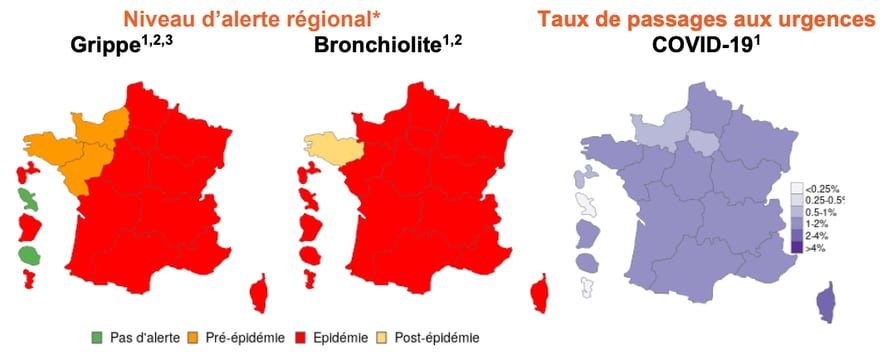Italian hospitals are overwhelmed. Spain has just called for the temporary return of masks in hospitals. The outbreak of infections linked to respiratory viruses, including Covid-19 and its Omicron JN.1 sub-variant, bronchiolitis and, above all, influenza, is posing an increasing problem in these two countries. In France, the situation is less worrying, for the moment. According to the latest Public Health France bulletin, flu indicators are sharply increasing. Ten regions are in an epidemic situation, and three – Brittany, Normandy and Pays de la Loire – are in a pre-epidemic phase. They should nevertheless change quickly. “And we are not yet at the peak of the epidemic, which should occur at the end of January, beginning of February,” warns epidemiologist Antoine Flahault, director of the Institute of Global Health, at the university’s faculty of medicine. from Geneva.
According to this expert, if the Christmas holidays helped slow the epidemic, it was only temporary. “When a flu epidemic starts a little before Christmas, like this year, we observe a slowdown, because these holidays are very cultural in France and are similar to a form of self-containment which creates favorable conditions for a break in the chains of contamination: schools and universities close, most offices too, people reduce their social contacts and stay at home, public transport is reduced,” he explains. But, then, the epidemic rises sharply to a peak which is accompanied by hospital tensions. The latter can be amplified by the conjunction of epidemic waves, as is the case in Spain and Italy.
Regional alert level for influenza and bronchiolitis epidemics and emergency rate for Covid-19 in France, as of January 3, 2024.
© / Frane Public Health, OSCOUR network, SOS Médecins, Sentinelles network
France could, however, benefit from favorable conditions, since the spread of bronchiolitis – which mainly affects babies – is slowing down for the fourth consecutive week, indicates Public Health France. Sars-CoV-2 indicators in community medicine and hospitals are also decreasing, but its circulation remains high. “The peak of Covid-19 was reached before the holidays, however it is not impossible that it will rise again, we must remain vigilant,” specifies Professor Flahault. In this context, experts all emphasize the need to wear a mask when experiencing symptoms such as coughing or sneezing, particularly in busy places and in the presence of vulnerable people. Hand washing and regular ventilation of enclosed spaces are also recommended. Finally, health authorities recall the importance of vaccination.
The shunned but useful flu vaccine
Unfortunately, European countries have generally avoided recalls until now, except in the United Kingdom. In France, the flu vaccination rate for people over 65 is around 25%, compared to 70% in the United Kingdom. “The British benefit from a very well-established public health policy and an involved public power: the notion of protection against the flu has been part of everyday life for a long time, notes the epidemiologist. There are, for example, campaigns aimed at go and vaccinate elderly people where they are, that is to say in accommodation establishments for dependent elderly people [Ehpad]but also directly to their home.”
A definite advantage. Because, although vaccines against these diseases are not perfect – they provide little protection against infections – they remain useful against serious forms. The influenza vaccine was, as every year, developed on the basis of projections by WHO experts in February 2023 by integrating the three strains of influenza: A/H1N1, A/H3N2 and B. But, as this virus mutates quickly every year, it’s still a gamble. Thus, the current vaccine is particularly effective against H1N1, which is good, since it is the majority strain in France, according to data from the Sentinels network and national reference centers (CNR). On the other hand, it is less effective against H3N2, which causes the most serious forms. The latter circulates a little less than H1N1, but nevertheless remains present in France. Strain B, less dangerous, hardly circulates.
But is there still time for an injection, when the peak is soon upon us? “Yes, because the epidemic started about twenty days ago and should last another six or seven weeks,” estimates Professor Flahault, who recalls that, as everyone has already been exposed to the flu in the past, a injection is equivalent to a booster dose. It therefore proves effective in just a few days.
.
